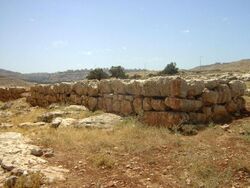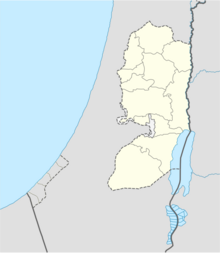Unsolved:Qubur Bani Isra'il
 | |
| Location | West Bank |
|---|---|
| Coordinates | [ ⚑ ] 31°50′32″N 35°16′08″E / 31.842250°N 35.268950°E |
| Type | tomb |
| History | |
| Material | local stone |
Qubur Bene Isra'in[1][2][3] or Qubur Bani Isra'il[4][5] (lit. "Tombs of the Children of Israel"), are four, formerly five, huge stone structures dated to the Middle Bronze Age, which rise from a rocky plateau overlooking Wadi Qelt in the West Bank, about 3.5 miles northeast of Jerusalem, between Hizma and Geva Binyamin along Highway 437.
History
Clermont-Ganneau, followed by Macalister, identified the site with the tomb of the biblical matriarch Rachel based on the biblical text (1 Samuel 10:2).[6][3] It can be hypothesised from the name Qaber Um Bene Israin, "Tombs of the Mothers of the Sons of Israel", that this is the tomb of Rachel (see 1 Samuel 10), or that there is a connection to the death and burial of the nurse Deborah "below Bethel" from Genesis 35:8, as well as to the passage about the oak of Tabor being near Rachel's tomb in 1 Samuel 10.[3]
The Israel Antiquities Authority survey gives the site the identification code Hizma, site number 480 in Benjamin, coordinates 17580 and 13880.[7] Archaeological evidence shows that the site was occupied during the Middle Bronze Age.[7] Excavation work was executed by Tzur Abeles,[8] who published the results in 1997.[9]
There were originally five structures, but one was demolished in the late 1980s to make way for the Ramallah bypass road.[10]
Louis-Hugues Vincent researched the site and found five very large stone structures, between 10 and 53 metres long and 2.8-6.62 metres high, each with a funerary room in its centre.[3] The rough-hewn stone blocks form rectangular walled structures.[11] Vincent studied the building style and drew the conclusion that they were erected by Bronze Age nomadic shepherds, who would bring their dead back here and bury them inside the structures.[3]
When Vincent asked local inhabitants for the name of the site, they said Qubbur Bene Israin, "Tombs of the Sons of Israel". They called the largest structure Qaber Um Bene Israin, "Tomb of the Mother of the Sons of Israel".[3][2]
See also
- Hiking in Israel
- Israeli archaeology
References
- ↑ Othmar Keel, Max Küchler (1982) (in German). Orte und Landschaften der Bibel: ein Handbuch und Studienreiseführer zum Heiligen Land, Band 2: Der Süden. 2 (1st ed.). Vandenhoeck & Ruprecht. pp. 608, 990, 991. ISBN 978-3-525-50167-2. https://books.google.com/books?id=j3jsKqzuP5YC&pg=PA608. "qubur bene-israin"
- ↑ 2.0 2.1 Christine Ritter (2003) (in German). Rachels Klage im antiken Judentum und frühen Christentum: eine auslegungsgeschichtliche Studie. Arbeiten zur Geschichte des antiken Judentums und des Urchristentums (Book 52). Brill. p. 32. ISBN 9004125094. https://books.google.com/books?id=7wW7FqSQppAC&pg=PA32. "qubur bene 'israïn"
- ↑ 3.0 3.1 3.2 3.3 3.4 3.5 Frederick M. Strickert (2007). Rachel Weeping: Jews, Christians, and Muslims at the Fortress Tomb. Michael Glazier/Liturgical Press. p. 69. ISBN 9780814659878. https://books.google.com/books?id=DXAJAN5BB0MC&pg=PA69. "Qubbur Bene Israin"
- ↑ Yitzhaki, Arieh, ed (1979). "Wadi Qelt" (in he). Israel Guide - The Judean Desert and The Jordan Valley (A useful encyclopedia for the knowledge of the country). 5. Jerusalem: Keter Publishing House, in affiliation with the Israel Ministry of Defence. p. 77. OCLC 745203905.
- ↑ Palestine Open Maps (Palestine 1940s)
- ↑ American Schools of Oriental Research (1931). Bulletin of the American Schools of Oriental Research. American Schools of Oriental Research. p. 50. https://books.google.com/books?id=jO8SAAAAIAAJ. "Clermont-Ganneau, followed by Macalister, identified them with the tomb of Rachel referred to in I Samuel x:2."
- ↑ 7.0 7.1 Archaeological Survey of the Hill Country of Benjamin. Jerusalem: IAA Publications. 1993. p. 63.
- ↑ Excavation Permits granted by the Staff Officer for Archaeology in the West Bank, 1968-2007
- ↑ Bibliography list
- ↑ Etshalom, Yitzchak, Kever Rachel: The "Northern Theory", see part VII (pg. 6)
- ↑ H. Vincent, "Chronique", Revue Biblique 1901, pp. 287-289
Further reading
- Louis-Hugues Vincent, "Cronique", Revue Biblique (1901), pp. 287–89
- Charles Simon Clermont-Ganneau, Archaeological Researches in Palestine in the Years 1873-74, London: Palestine Exploration Fund, 1899
- R.A.S. Macalister, The Topography of Rachel's Tomb, Palestine Exploration Fund Quarterly (1912), pp. 74–82
- Guido Lombardi, H. Farah – W. Farah presso Anatot e la questione della Tomba di Rahel (Gen 35,16-20; 1 Sam 10,2-5; Ger 31,15)", Liber Annuus, XX (1970), pp. 299-352 (about the Qubur: 323-32). Later republished as a monograph, Guido Lombardi, La Tomba di Rahel (Franciscan Printing Press, Jerusalem, 1971).
- Hareuveni, Nogah: Desert and Shepherd in Our Biblical Heritage, 1991, translated by Helen Frenkley. Kiryat Ono: Neot Kedumim.
External links
- Photos
- Millar Burrows (1932). "From Director Burrows' Reports on the Work of the School in Jerusalem". Bulletin of the American Schools of Oriental Research (American Schools of Oriental Research) 46 (46): 9–13. doi:10.2307/1354879. ISSN 2161-8062.
 |


